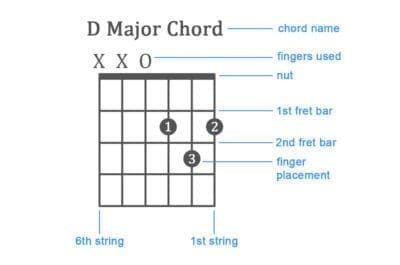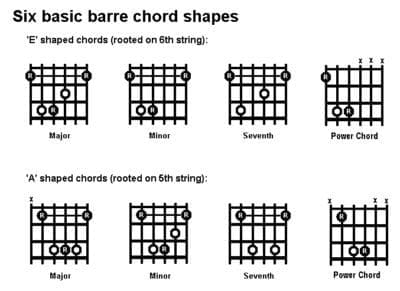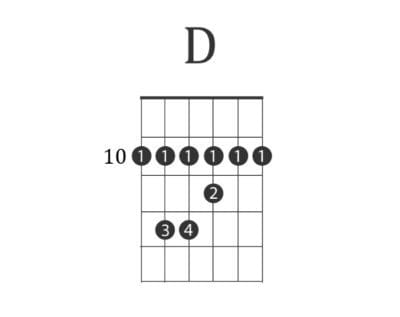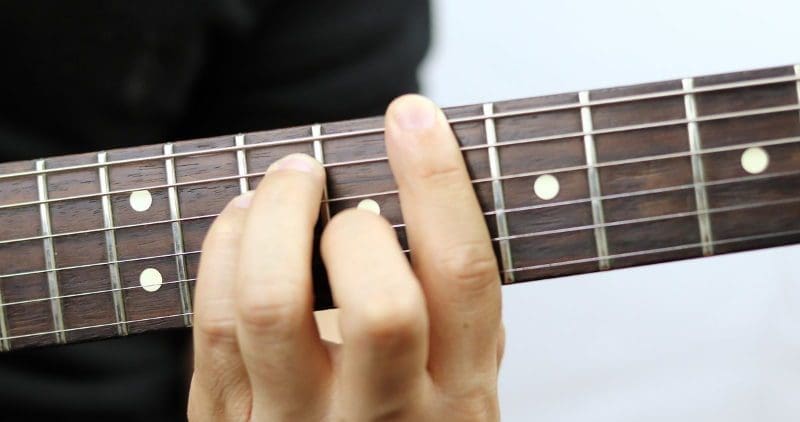Last update 5/2/2024
One of the best things you can do to advance to the next level with your guitar is to learn how to play barre chords properly.
Table of contents
They are commonly found in almost all styles of music. Furthermore, having a good grasp of playing them (and playing them correctly) will significantly enhance all you can do with the instrument. That being said, barre chords often get a bit of a bad rap, especially with most beginners. That’s because they can be challenging to pull off without substantial practice time.
Why play barre chords
We’re going to take a quick overview of a barre chord. Also, what are the benefits of learning them and some tips and tricks to help ensure you’re playing them correctly?
What is a barre chord, and how are they different from open chords?
You will be forgiven for thinking about what barre chords are. Most beginners are familiar with what are called ‘open chords.’ These are chords that are played down near the nut. A key characteristic is that one or more strings are played open without putting the finger on a fret higher up the neck. Therefore, each finger’s sole purpose is to fret only one note. Below is the most common fingering for an open D chord:


Barr chords – pretty simple, right?
A barre chord is a different way of playing the same chord. They come in six primary forms, as shown below:


The main difference is that, with barre chords, you use one (or more) of your fingers to hold down more than one string at a time.
But why would you choose to play a barre chord over an open chord? Especially if playing an open chord might be more accessible.
Positioning on the neck
Depending on the song you’re playing, it might be inconvenient to have to jump all over the neck. Use our D chord as an example if you’re wailing away on a solo above the 12th fret. It’s much easier to hit that D chord using a barre formation at the 10th fret. That is easier than going down by the nut to play the open D formation.


Flexibility and movability


Take a good look at the barre chord chart diagrams above. Do you notice anything familiar about them?
The second one, the A shape, looks like an open A chord, except your 1st finger acts as the nut. Note: The low E string isn’t meant to be played. The first diagram, the A shape, looks like an open E chord, but your first finger acts as the nut in that case.
Why is this a big deal? It means that both chord forms are movable. That is to say, you can use the same fingering pattern on different frets to play different chords.
Take the D chord form with your 1st finger on the 5th fret. Move that same formation up two frets, and you have an E chord. Move it down three frets, and you have a B chord. The same concept holds for the other fingering pattern. That is the one that starts at the 10th fret. Take that same shape down five frets, and you have an A chord. Now, move up to the 8th fret and have a C chord.
Keeping this all in mind, you can see that barre chords are amazingly flexible. They offer a great way to play the chords you need at different positions all over the neck.
How to play a barre chord
All of that’s great, but aren’t barre chords hard to play?
We won’t sugarcoat it here. Yes, they can be tricky to play the right way when you first try it. However, having one finger hold down several strings simultaneously may feel unnatural. Therefore, it will take some getting used to.
Here are a few tips for you to help move things along:
Use the correct grip on the neck.
Having your fretting hand in the correct position will make a massive difference in how well you can play a barre chord. Our recommendation is as follows. Ensure your thumb is placed firmly on the back of the neck to help you get the correct pressure.
Don’t go too hard.
Speaking of pressure, a common mistake among beginners is to use too much finger pressure. It’s understandable; you’re trying to fret all of those strings. You think the best way to do it is to press down as hard as possible. In reality, too much pressure can be a bad thing. It will tire your hand out, but you may make your strings go sharp by pushing down too much. This is more common with electric guitars with thinner strings than acoustic ones. Over time, you’ll learn just the right amount of finger pressure. However, it is most likely to take some trial and error at the start.
Play one string at a time.
One of the biggest problems with playing barre chords is ensuring that all notes ring out properly. Playing each chord note is an excellent way to ensure you’re fretting the strings correctly. Do this one at a time. Let each one ring out. If you hear some muffled or dead notes, you’ll know that you’re doing something wrong.
That being said, if you have some dead notes when you first try tackling them. Please don’t fret about it (pun entirely intended). As a heads up, you may be more likely to silence a few notes when you’re trying to play a song and are switching from one chord to another.
Please make it a personal goal to switch between different barre chords easily. Practice playing different chord progressions by starting slowly and then building up your speed as you get better and better over time.
Guitar setup
Ensure your guitar does not have setup problems. In short, this means that the guitar has been optimized for all its adjustments by an experienced luthier. A correctly created guitar will be as easy to play as possible by ensuring the action is correct. Correct action means the strings are set at the optimal height above the frets along the fretboard’s entire length for the player’s requirements.
Fretting notes and chords will be complex if the action is too high. As a consequence, you’re making the guitar hard to play. Action that is too low may result in string buzz. This occurs when the strings come into contact with the frets when played.
Conclusion
Having a solid understanding of what barre chords are and how they work. Developing the proper techniques to play them properly is a skill set that almost every guitar player must master. They are handy in multiple genres; you’ll find them in tons of your favorite songs.
While learning to play them is critical. The simple fact is that barre chords aren’t the easiest thing in the world to play. But you can get them right; it’ll just take some patience on your part. Don’t beat yourself up if you don’t play them perfectly right out of the gate. Take it slow at the start and build your skills over time. The next thing you know, you’ll be ripping them out like a seasoned pro!



